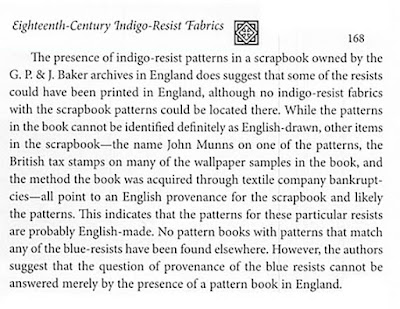In her 2014 update of Florence Montgomery's catalog of Winterthur Museum textiles curator Linda Eaton showed this pheasant and floral resist-style fabric, indicating that the cotton (with a bit of linen in the yarns) was "Printed in Britain 1760s-70s."
Eaton cited that 1956 conference at the Cooper-Union Museum. Although curators Hathaway & Beer reporting on the results of that meeting were hesitant to credit a geographic source Eaton summarized conference results with the idea that the source was Britain as evidenced in the piece above. (See more about Hathaway & Beer at this post:
Barbara Brackman's
MATERIAL CULTURE: Indigo Resist #2: "How Fools Rush In"
https://quiltindex.org/view/?type=page&kid=35-90-283“Eighteenth-Century Indigo-Resist Fabrics: Their Use inQuilts and Bed Hangings,” Uncoverings 2004
"The question of provenance of the [early] blue resists cannot be answered merely by the presence of a pattern book in England."
References
Mary Gale & Margaret T. Ordoñez,
"Indigo-Resist Prints from Eighteenth-Century America: Technology and
Technique," Clothing and Textile Research Journal. vol. 22
(Jan./March 2004): 4–14.
Mary Gale & Margaret T. Ordoñez, “Eighteenth-Century Indigo-Resist Fabrics: Their Use in Quilts and Bed Hangings” Uncoverings 2004, Volume 25 of the Research Papers of the American Quilt Study Group. https://quiltindex.org/view/?type=page&kid=35-90-283
Gale, M. E. (2001). Indigo-resist prints from eighteenth-century America: Production and provenance. Unpublished Master’s thesis, University of Rhode Island, Kingston.
Hassler, K. (1986). Printing procedures for the historic American blue resisted cloths. Unpublished Master’s thesis, University of Delaware, Newark.Pettit, F. H. (1975, 1976). The printed textiles of eighteenth-century America. Paper presented at the Irene Emery Roundtable on museum textiles: Imported and domestic textiles in eighteenth-century America, Textile Museum, Washington, D. C.










No comments:
Post a Comment